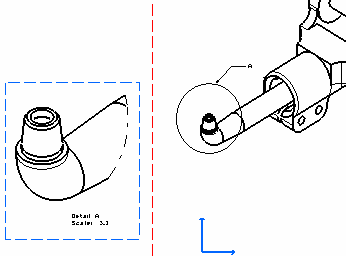Creating a Detail View / Detail View Profile
This task will show you how to create from the 3D a detail view using either a circle as callout or a sketched profile. In this particular case, we create a detail view using a sketched profile as we create this detail view from an oblong part. Note that for creating a detail view using a circle, the dialog is exactly the same. A detail view is a partial generated view that shows only what is necessary in the clear description of the object. Note that, the Detail view command uses a Boolean operator from the 3D whereas the Quick Detail view command computes the view directly from the 2D projection. The representation is therefore different. |
| Before You Begin, make sure you customized the following settings:
Grid: View names and scaling factors: 3D colors inheritance: |
| Open the GenDrafting_isometric_view.CATDrawing document. | ||||||
| 1. Click the Drawing window, and click
the Detail View icon 2. Click the callout center. 3. Drag to select the callout radius and click a point to terminate the selection.
|
 |
|||||
 |
||||||
| Or...
...If you create a detail view using a sketched profile, you will click the Detail View Profile icon
2. Create the points required for sketching a polygon used as profile. 3. Double click to end the cutting profile creation.
|
||||||
|
||||||
|
|
||||||
| The dress-up elements generated from the 3D are identified and represented in the
generated detail view whereas it is not when generating quick
detail views.
4. Click to generate the detail view. The default scale is 2 (twice the scale of the active view). You can modify this scale. 5. Right-click the detail view and select the Properties option from the contextual menu, View tab. Enter the desired Parameters Scale, for example 3 and then click OK in this Properties dialog box.
|
||||||
| You can insert Bill of Material information into the active view. | ||||||
|
||||||

